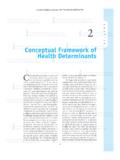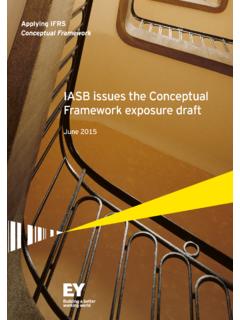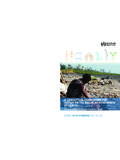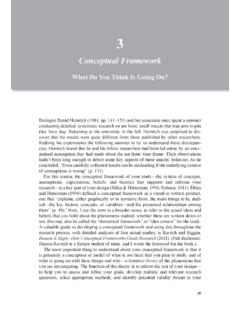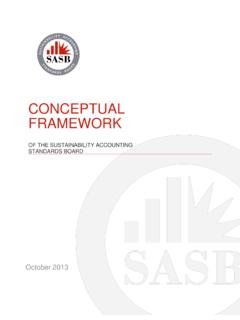Transcription of A guide to understanding theoretical and …
1 Sinclair M. (2007) Editorial: A guide to understanding theoretical and conceptual frameworks. Evidence Based Midwifery5(2): 39 2007 The Royal College of Midwives. Evidence Based Midwifery5(2): 3939 Mentioning theoretical framework or conceptual framework to midwives is likely to be met with either silence, a shrug of theshoulders or an arched eyebrow that says I know what you aretalking about, but please don t ask me too much about it .These reactions are understandable, but I hope that this briefeditorial will help novice researchers, educationalists and clini-cal midwives to grasp the essence of theoretical frameworks andtheir potential contribution to midwifery theoretical framework can be thought of as a map or travelplan. When planning a journey in unfamiliar country, peopleseek as much knowledge as possible about the best way totravel, using previous experience and the accounts of others whohave been on similar trips.
2 Survival advice and top tips enablethem to ascertain the abilities, expectations and equipment thatmay help them to have a successful journey with good outcomes,to achieve their objectives and return to base safely. At the start of any research study, it is important to considerrelevant theory underpinning the knowledge base of the phenom-enon to be researched. By addressing simple questions, the researcher can begin to develop a loosely-structured theoreti-cal framework to guide them. The following questions have beenadapted from Slevin and Basford (1999: 298): What do I know about the phenomenon that I want to study? What types of knowledge are available to me (empirical,non-empirical, tacit, intuitive, moral or ethical)? What theory will best guide my midwifery practice? Is this theory proven through theory-linked research?
3 What other theories are relevant to this practice? How can I apply these theories and findings in practice?In considering these questions and critically appraising the liter-ature, the quantity of information that emerges can be cumber-some, and it is often unclear whether it can be brought togetherto build something meaningful, aesthetically pleasing and scien-tifically sound. To address this, researchers consider manyconstructs or permutations amalgamations, definitive proper-ties, relationship differentials, knowledge derivatives and prac-tice outcomes and effects. This search for theoreticalunderstanding and its translation into meaningful practice iswhat is done when developing a theoretical or conceptualresearch framework. This framework must have a clear practiceoutcome, if it is to be of clinical considered knowledge outcomes from the literaturecarefully, permutations or links between these can be projectedand predictions made on how relationships might impact onoutcomes.
4 These concepts move from being completely abstractand unconnected to becoming a tentative or loose framework toexplore and test theory. Alternatively, relationships betweendifferent concepts can be observed using grounded theoryresearch, and used alongside theoretical constructs to testemerging theories by deliberately manipulating the variables. Research is a journey toward an endpoint to develop newknowledge that will contribute to practice and a theoreticalmap provides a guide . In the case of a field trip, it can be theo-rised that factors such as body mass index and fitness levelsmay determine whether individuals will achieve their objectivesor not. These assumptions are based on knowledge and under-standing of environmental stressors, personality traits, forexample.
5 Similar processes of enquiry and synthesis of data arerequired in developing a theoretical research preparatory work leads to the identification of certainfactors that are likely to have an impact on the outcome thiscan be likened to a crystallisation process in which emerging ortentative factors that are relevant to the research study begin tomake themselves visible. The next stage of the process involvesmapping out or visualising these theoretical threads to formsome diagrammatic representation of is important to avoid producing linear or circulardiagrams. Successful theoretical constructs such as Maslow spyramidal hierarchy of needs or Bruner s spiral theory of learn-ing can provide inspiring mental images of frameworks thathave anchored previous knowledge and theory development.
6 Researchers often get excited by the aha moment, whenthey begin to see the relevance of theories about adaptation,motivation and decision-making, for example and how they canhelp formulate research questions, select an appropriateresearch design and report findings within a structured frame-work. This is only the beginning of the theoretical journey once the relevant theories or constructs have been identified,their place in the caring context clearly articulated and tentativerelationships between them posed, the research study canprogress rapidly. However, it is important to review the frame-work and synthesise data outcomes at each stage of the researchprocess to further develop, test or confirm relationshipsbetween the variables. The theoretical framework evolves anddevelops until it becomes refined and burnished, to emerge as arobust outcome of the research.
7 The process of designing a theoretical framework is develop-mental and experiential. I would argue that the personaljourney is a life-changing event for many researchers, and onethat should not be feared. The journey toward theoretical know how and know what is worthy of careful planning andpreparation. It starts with reading the literature, asking basicquestions, describing and defining relationships and proposingpotential links between emerging factors. The end result ofsound theoretically-based research is filtration and absorptionof knowledge that trickles and merges into the thought process-es and senses of clinicians. If midwifery research is to be effica-cious and effective, its contribution must be made visible better research, underpinned by sound theory and leading todemonstrable effects on SJ.
8 (1966) Toward a theory of instruction. Harvard University:Cambridge, AH. (1970) Motivation and personality (second edition). Harperand Row: New O, Basford L. (1999) Theory and practice of nursing: an integratedapproach to caring practice (second edition). Stanley Marlene SinclairEditorA guide to understanding theoretical and conceptual frameworks

